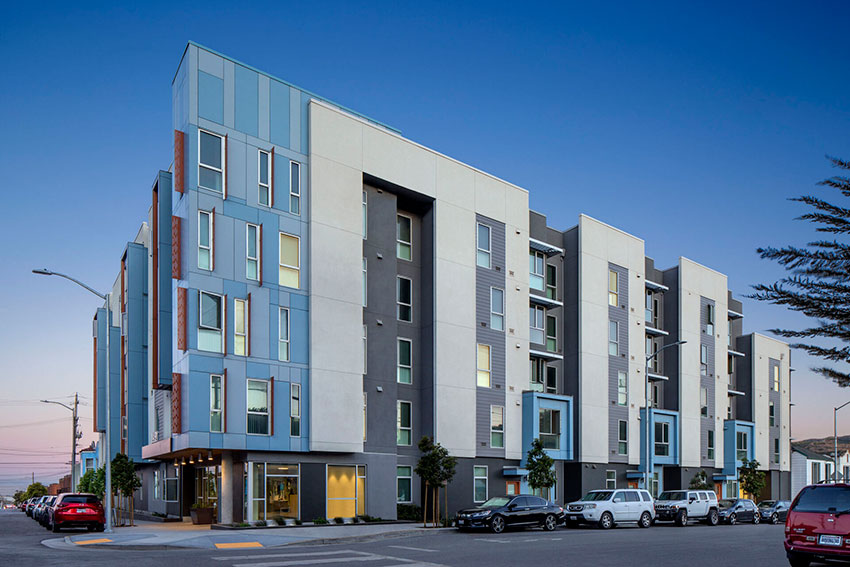A Metal for All Projects
LEED CREDITS
Green building codes and programs, including LEED, now look at the overall indoor environmental quality of a building in addition to energy efficiency and other issues; this includes the benefits of daylighting and views for building occupants.
The importance of LEED certification in modern architecture can’t be stressed enough, and as a flexible, sustainable, and durable building material, aluminum plays well in achieving credits. This is especially true when architects select a single-source manufacturer that can provide a full complement of building products, like fenestration. A single-source manufacturer can simplify the process by providing the necessary documentation for an entire suite of products on a project.
LEED credit requirements cover the performance of materials as a whole and do not assess the performance of individual products or brands. Specific products or materials can only contribute toward earning LEED certification points; they cannot earn points individually themselves.
For aluminum fenestration, there is a wide range of potential credit points possible.
LEED v4 MR Credit: Building Product Disclosure and Optimization
One applicable example is the Materials and Resources (MR) credit Building Product Disclosure.
- Sourcing of Raw Materials (possible 2 points): The intent of this credit is to encourage the use of products and materials for which life-cycle information is available and that have environmentally, economically, and socially preferable life-cycle impacts, and to reward project teams for selecting products verified to have been extracted or sourced in a responsible manner.
- Material Ingredients (possible 2 points): The intent is to encourage the use of products and materials for which life-cycle information is available and that have environmentally, economically, and socially preferable life-cycle impacts; to reward project teams for selecting products for which the chemical ingredients in the product are inventoried using an accepted methodology, and for selecting products verified to minimize the use and generation of harmful substances; and to reward raw material manufacturers who produce products verified to have improved life-cycle impacts. It is easy to see how the positive attributes of aluminum windows and doors can contribute to credits in these categories.
- Environmental Product Declarations (possible 2 points): The intent of this credit is to encourage the use of products and materials for which life- cycle information is available and that have environmentally, economically, and socially preferable life-cycle impacts, and to reward project teams for selecting products from manufacturers who have verified improved environmental life-cycle impacts. We will look at achieving the first option:
Option 1. Environmental Product Declaration (EPD) (1 point) Use at least 20 different permanently installed products sourced from at least five different manufacturers that meet one of the disclosure criteria below.
- Product-specific declaration
- Products with a publicly available, critically reviewed life-cycle assessment conforming to ISO 14044 that have at least a cradle-to-gate scope are valued as one-quarter of a product for the purposes of credit achievement calculation.
- Environmental Product Declarations that conform to ISO 14025, 14040, 14044, and EN 15804 or ISO 21930 and have at least a cradle-to-gate scope.
- Industry-wide (generic) EPD: Products with third-party certification (Type III), including external verification, in which the manufacturer is explicitly recognized as a participant by the program operator, are valued as one-half of a product for purposes of credit achievement calculation.
- Product-specific Type III EPD: Products with third-party certification (Type III), including external verification in which the manufacturer is explicitly recognized as the participant by the program operator, are valued as one whole product for purposes of credit achievement calculation.
- USGBC-approved program: Products that comply with other USGBC-approved environmental product declaration frameworks. The credit also outlines another option that uses LCAs. The industry has conducted both LCAs and EPDs. There are a few changes to this credit in the newest LEED version, v4.1.
Many of the issues identified by LEED for credits are recognized by other building standards as well. The International WELL Building Institute (IWBI) is a public benefit corporation whose mission is to improve human health and well-being in buildings and communities across the world through its WELL Building Standard (WELL).
The WELL Building Standard also recognizes the importance of enhanced daylight access and requires projects to design spaces to integrate daylight into indoor environments so that daylight can be used for visual tasks along with electric lighting, and to provide windows and doors that connect the occupants with the outside world.

Photo by David Wakely; courtesy of All Weather Architectural Aluminum
Parcel Q is the first phase of the redevelopment of San Francisco’s largest public affordable housing site, Sunnydale. The project includes thermally enhanced aluminum windows to improve energy efficiency and durability.
CONCLUSION
In conclusion, aluminum emerges as a versatile and enduring choice for window and door products across a spectrum of construction projects. Its adaptability finds expression in commercial spaces, single-family residences, multifamily dwellings, healthcare facilities, and educational buildings. The physical resilience of aluminum stands out, providing a long-lasting and low-maintenance solution even in the face of challenging weather conditions. This inherent durability, coupled with its lightweight nature, makes aluminum a standout material that enhances the performance, durability, and sustainability of windows and doors.
Furthermore, the strategic decision to engage a single-source manufacturer for window and door products proves to be a pivotal choice in ensuring project success. The advantages are manifold, ranging from simplified ordering processes to streamlined project management. With consistent products and dedicated installation support, architects can focus on the creative and technical aspects of their designs, confident that the final outcome will align seamlessly with their vision.
Andrew A. Hunt is Vice President of Confluence Communications and specializes in writing, design, and production of articles and presentations related to sustainable design in the built environment. In addition to instructional design, writing, and project management, Andrew is an accomplished musician and voice-over actor, providing score and narration for both the entertainment and education arena. www.confluencec.com



